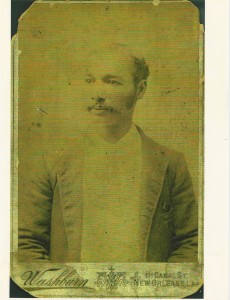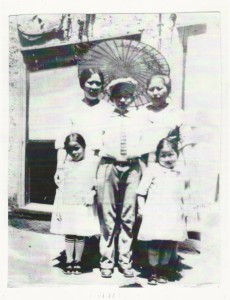I knew about the lynching of my great, great grand uncle in Ocean Springs, Mississippi for many years. It was a family secret that I learned about almost by accident. After seeing photos of a battered, distorted, slain face of Emmett Till in Jet Magazine, I asked my father if anything like that had happened in our family. I was shocked when he said calmly yet gently: ‘Yes.’ He said that his grandfather’s brother, Warren Stuart was lynched in 1901. That’s it. No discussion. I got the impression that I dare not ask another question. I later learned that Uncle Warren was a milkman in our family’s dairy and animal husbandry business. Elders described him as ‘cheerful, kind, hard-working, handsome and strong.’ The Stuarts were, by all accounts, a prosperous African American family, the first generation out of slavery. But some years after the lynching, my family abandoned everything and made their ‘escape’ from the South to Harlem. They never looked back. Unlike most Southern families who returned ‘home’ for summers and holidays, we never went back.
I tucked away the lynching in the back of my mind for years until I mentioned it to my new young cousins Monique and Dionne, who found me through a genealogy search. They sent me shocking newspaper clippings. It was the first time that I read about the lynching details as published in Southern, Midwestern and even Trenton, New Jersey newspapers. I noticed that some of the articles changed my uncle’s name and age from Warrant Stuart to Warren Matthews, from 30 to 80 years old! Also the accuser’s name and age changed in each re-telling from 13 year-old White girl to a 26 year-old woman Rosaline or Ethel Fountaine or Fentian. Re-publishing lynching incidents was very popular back then because it served to flaunt White Supremacy and racism and further terrorize and humiliate the entire African American community. The lurid details of my dear Uncle Warren’s lynching still sounds as disturbing today as a century ago:
Negro Fiend Lynched by Mississippi Mob…Orderly Lynching at Ocean Springs.
Negro Brute…was dragged about a mile back to town and hanged. Everything was done in an orderly, humane manner…before execution. –(Alabama newspaper, 1901)
Some papers like the New Orleans Daily urged the public to join in an orgy of vigilante vengeance:
Ocean Springs Citizens Take Swift Vengeance!
Warren Stuart, a Negro who Attempted to Assault Miss Ethel Fountaine Strung Up. His Body Riddled with Bullets…Negro Taken from Court Offices by a Mob of about One Hundred and Fifty Determined Men. Begs Piteously for His Life. –(New Orleans Sunday Daily, February 3, 1901).
The Body of Negro Warren Stuart (Matthews) Taken by Relatives… the Negro who was lynched last night was found this morning hanging from the broken limb of a persimmon tree beside the country road…The verdict was that the death was due to strangulation and gunshot wounds. The body was taken in charge by the man’s relatives.
–(New Orleans, 1901)

One of the persons described as the “man’s relatives,” who took his body home was my great, great grandfather, Alfred Burton Stuart aka Papau. These events happened over a century ago, and my family never discussed them, not even my magnificent grandmother, Madame Tempy Stuart-Smith who, according to other relatives, was a witness. And while todayI can only imagine the past through old clippings, photographs and stories, I am haunted nonetheless by Warren Stuart’s pain, his piteous cries for mercy, and my family’s impotence. Without hope of justice my great, great grandfather was forced to carry home and bury his only brother, and keep silent.
Like most of us, I have no direct experience with anything like my uncle’s lynching. Yet the details enraged me to the point that I’ve considered confronting the descendants of Miss Ethel Fontaine, the woman who falsely accused my great grand uncle and everyone involved. This was a ‘community crime.’ Why should I honor a code of silence? I continue to research the descendants of the accuser and that of the sheriff, judge and some townspeople. Why? Because I still don’t know the whole story. Maybe Rosalie was put up to it. Maybe one descendant felt remorse and desires dialogue. Could I overturn the case and clear my uncle’s name? Should my family seek reparations? What might I gain from my search? Probably nothing. But it would be an action to counter the silence, fear and shame that is a legacy of those years. What comforts me is knowing that some people in our nation are willing to acknowledge and take responsibility for this unfortunate era of our past by taking positive steps to heal its wounds.
I was asked what would be a healing metaphor that could help me and others empathize with my feelings of anger and sadness about how this experience touched me. I chose two musical metaphors Strange Fruit, sung by Billy Holiday. http://www.youtube.com/watch?v=YbcZstt8ACY). The haunting lyrics were actually a banned poem written in the 1930s by Abel Meeropol, (aka Lewis Allan) a Jewish schoolteacher and Bronx labor organizer who was disturbed by a photograph of a lynched Negro. Meeropol and his wife Anne are also notable because they adopted Robert and Michael Rosenberg, the orphaned children of the executed communists Julius and Ethel Rosenberg.
The other song is Lift Every Voice, aka the National Negro Anthem, (http://www.c-spanvideo.org/program/162576-1) by James Weldon Johnson. This is a song that my paternal grandmother, Madame Tempy Stewart Smith, a noted Harlem music teacher, and lynching eyewitness, made a tradition of directing her pupils to lead the audience in singing at recitals.
Today, very few in my family will talk about slavery, lynching, segregation, racism, Jim Crow, Civil Rights and related topics. They said: “Forget the past…” So, I was encouraged to join Coming to the Table (CTTT- www.comingtothetable.org), a dialogue group that responds to the harms of slavery for both the descendants of the slaves and enslavers. I was directed to a CTTT member who acknowledged that she was a descendant of an enslaver and Klansman. She continues to assist me in my search to find out more about the case, people and town. CTTT also plans to establish dialogue groups for members who experienced lynchings in their families—both descendant of lynchers and the lynched.
As an African American descendant of a slave and enslavers, I felt a healing balm from the White CTTT members who teach about White Privilege and who believe that they are ‘accountable.’ They courageously advocate that schools teach American history with a focus on slavery’s legacy, aftermath and post traumatic slave syndrome. The strength of CTTT is the open dialogue and ongoing conversations between White and Black people. I believe that groups like CTTT are a catalyst for change in America. I do believe as we work and talk together that a true platform can be built to heal America. We are far from being a post-racial nation

